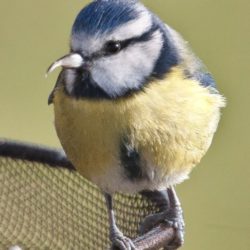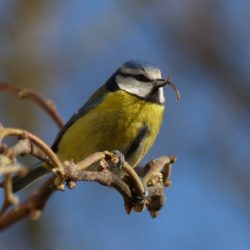Agent
A number of factors have been confirmed or proposed as causes of beak abnormalities in wild birds. These include exposure to environmental contaminants and pesticides, physical trauma, nutritional deficiencies, infectious agents, and congenital malformation.
Since the late 1990s, a condition called avian keratin disorder (AKD) has emerged in wild birds in Alaska (USA) and is associated with beak overgrowth and/or abnormalities. A virus within the family Picornaviridae has been identified in the affected birds and is thought to be the cause of AKD, although additional research is required before this can be confirmed.
There is no current evidence that AKD is emerging in Europe as has occurred in North America. It is currently unknown whether similar picornavirus infections occur in wild birds in Great Britain (GB).
Whilst similar abnormalities have been documented in wild birds in the United Kingdom, these occur relatively infrequently, and further investigations are required to understand the causes of the condition in this country.
For beak abnormalities of parrots (e.g., the free-living ring-necked parakeet (Psittacula krameri) in GB), please see our factsheet on psittacine beak and feather disease (https://www.gardenwildlifehealth.org/portfolio/psittacine-beak-and-feather-disease/).
Species affected
Beak abnormalities can affect any wild bird species and have been reported worldwide, typically at a sporadic and low level of occurrence. In GB, the Eurasian blue tit (Cyanistes caeruleus) and the Eurasian blackbird (Turdus merula) are the species in which beak abnormalities have most frequently been recorded, although the level of occurrence remains very low.
AKD has been reported in black-capped chickadees (Poecile atricapillus) and other wild bird species in North America, particularly in corvids, raptors, and passerines. The prevalence of AKD in black-capped chickadees and northwestern crows in Alaska represent the highest rates of beak deformities ever observed in wild birds.
Signs of disease
Beak abnormalities include: crossed mandibles (caused by asymmetry of the jaw), curved upper/lower mandible (due to damage of the tip of the opposite mandible), and overgrown mandibles (which can lead to beaks with various degrees of curvature, warping sideways, or with a visible gap).
Depending on the severity of the beak abnormality and how rapidly it occurs (successful adaptation is less likely in cases of a sudden injury), affected birds will often be able to adopt alternative feeding postures and thus remain in good body condition. However, breeding and feeding of the offspring can be affected: research suggests that affected females tend to hatch fewer eggs and position them incorrectly in the nest, while affected males may struggle to feed their young. Furthermore, birds with beak abnormalities can experience difficulties with preening, leading to increased ectoparasite burden and poor plumage condition.
Figure 1. European blue tit (Cyanistes caeruleus) with overgrown upper mandible (photo credit Stephen Byard).
Figure 2. European blue tit (Cyanistes caeruleus) with crossed overgrown mandibles (photo credit Allan Roffey).
Disease transmission
Many beak abnormalities have non-infectious causes (for example genetic inheritance, trauma, or dietary deficiencies) and therefore they are not transmissible between birds.
In the case of AKD in Alaska, a novel picornavirus has been suggested as the causative agent but the geographical distribution and transmission routes for this virus remain unknown.
Distribution and origin
To date, beak abnormalities have been recorded in approximately 35 species of wild birds in GB, where they have been estimated to affect less than one in 200 adult birds. Currently, there is no evidence suggesting that beak abnormalities are of conservation concern, although they may negatively impact bird welfare in severe cases.
Blue tits, blackbirds, and rooks (Corvus frugilegus) are the species in which beak abnormalities have been most frequently reported in GB from a wide range of localities.
Further research into the cause, prevalence, distribution, and impact of beak abnormalities in wild birds in GB is required; whether the causes are primarily traumatic, congenital, environmental, or infectious remains currently unknown.
Risk to human health
No known risk to human health.
Risk to domestic animal health
Beak abnormalities, regardless of their cause, pose no known risks to domestic animal health. However, we recommend following sensible hygiene precautions as a routine measure when feeding garden birds and handling bird feeders and tables. Following these rules will help avoid the risk of transmitting any infection and help safeguard the birds in your garden against disease.
• Clean and disinfect feeders/feeding sites regularly. Suitable disinfectants include a weak solution of domestic bleach (5% sodium hypochlorite) and other specially-designed commercial products. Always rinse feeders thoroughly and air-dry them before re-use.
• Dampen surfaces with water before cleaning them to reduce the chance of breathing in dry dust or aerosolised secretions.
• Brushes and cleaning equipment for bird feeders, tables and baths should not be used for other purposes and should not be brought into the house, but be kept and used outside and away from food preparation areas.
• Wear rubber gloves when cleaning feeders and thoroughly wash hands and forearms afterwards with soap and water, especially before eating or drinking.
• Avoid handling sick or dead birds directly. For instance, use disposable gloves or pick a carcass up through an inverted plastic bag.
Diagnosis
Diagnosis of the cause of any beak abnormality cannot be based on appearance alone; due to the numerous potential causes, further investigations and specialist laboratory testing are required.
If you wish to report finding a dead bird with a beak abnormality, or signs of other disease in birds, please visit www.gardenwildlifehealth.org. Alternatively, if you have further queries or have no internet access, please call the Garden Wildlife Health vets on 0207 449 6685.
The British Trust for Ornithology runs a dedicated scheme called ‘Big Garden Beak Watch’ to gather information on the occurrence of beak abnormalities in wild birds. Please help by reporting sightings of live birds with beak abnormalities to this survey, attaching digital images when available (https://www.bto.org/volunteersurveys/gbw/about/background/projects/bgbw).
Prevention and control
Whilst some types of beak abnormalities in captive birds can be treated by veterinarians, effective treatment of free-living birds under field conditions is not possible.
In areas where beak abnormalities are found, it is advisable to follow routine hygiene and biosecurity measures in order to avoid transmission of potentially infectious agents (see ‘Disease transmission’ above).
Scientific publications
British Trust for Ornithology ‘Big Garden Beak Watch’: https://www.bto.org/volunteer-surveys/gbw/about/background/projects/bgbw
Zylberberg, M., Van Hemert, C., Dumbacher, J.P., Handel, C.M., Tihan, T. & DeRisi, J.L., 2016. Novel picornavirus associated with avian keratin disorder in Alaskan birds. MBio, 7(4): pp.e00874-16.
Van Hemert, C., Armién, A.G., Blake, J.E., Handel, C.M. & O’Hara, T.M., 2013. Macroscopic, histologic, and ultrastructural lesions associated with avian keratin disorder in black-capped chickadees (Poecile atricapillus). Vet Pathol 50: 500–513.
Handel, C.M., Pajot, L.M., Matsuoka, S.M., Hemert, C.V., Terenzi, J., Talbot, S.L., Mulcahy, D.M., Meteyer, C.U. & Trust, K.A., 2010. Epizootic of beak deformities among wild birds in Alaska: An emerging disease in North America? The Auk 127(4): 882-898.
Van Hemert, C., Handel, C.M., 2010. Beak deformities in northwestern crows: evidence of a multispecies epizootic. The Auk 127(4): 746-51.
Acknowledgements
Current funding for the GWH comes in part from Defra, the Welsh Government and the Animal and Plant Agency (APHA) Diseases of Wildlife Scheme (DoWS) https://ahvla.defra.gov.uk/vet-gateway/surveillance/seg/wildlife.htm; and from the Esmée Fairbairn Foundation and the Universities Federation for Animal Welfare.
Disclaimer
This fact sheet was produced by Garden Wildlife Health (GWH) for information purposes only. The GWH will not be liable for any loss, damage, cost or expense incurred in or arising by reason of any person relying on information in this fact sheet.
Date of last update
October 2018


